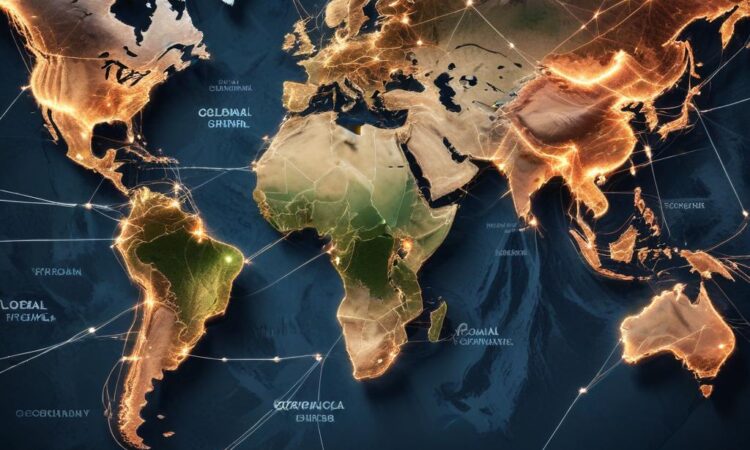Supply Chain Resilience and Geopolitical Risks
Geopolitical tensions and unpredictable events continue to disrupt global supply chains. Businesses are prioritizing diversification, near-shoring, and building more resilient supply chain strategies to mitigate future risks. Recent events like the ongoing conflict in Ukraine are highlighting the vulnerability of global supply chains.
The Impact of Geopolitical Instability
The interconnected nature of global supply chains means that disruptions in one region can quickly cascade across the entire system. Geopolitical instability, whether it’s armed conflict, trade wars, or political upheaval, creates uncertainty and volatility. This uncertainty makes it difficult for businesses to plan effectively, leading to increased costs, delays, and shortages.
For example, the conflict in Ukraine has significantly impacted the global supply of wheat, sunflower oil, and neon gas, crucial for semiconductor manufacturing. The war has also disrupted transportation routes and logistics, adding further complexity and expense to global trade.
Beyond the immediate impact of specific events, the broader geopolitical climate plays a significant role. Rising nationalism, protectionist policies, and a growing emphasis on national security are all contributing to a more fragmented and less predictable global economic landscape. Businesses are finding it increasingly challenging to navigate this complex environment and ensure the smooth flow of goods and services.
Strategies for Building Supply Chain Resilience
In response to these challenges, businesses are actively seeking ways to strengthen their supply chain resilience. This involves a multi-faceted approach that considers both short-term and long-term strategies. Key elements include:
Diversification
Reducing reliance on single suppliers or geographical regions is crucial. Diversifying sourcing and manufacturing locations helps mitigate the risk of disruptions from localized events. This might involve sourcing materials from multiple countries or establishing manufacturing facilities in different regions. Effective diversification requires careful assessment of risk factors, including political stability, infrastructure, and regulatory environments.
Nearshoring and Reshoring
Bringing production closer to home, through near-shoring (moving production to nearby countries) or reshoring (returning production to the domestic market), is becoming increasingly popular. This reduces transportation costs and lead times, while also enhancing control over the supply chain and mitigating geopolitical risks. However, it’s important to weigh the economic benefits of near-shoring against factors such as labor costs and regulatory hurdles.
Building Strategic Partnerships
Developing strong and reliable relationships with suppliers, logistics providers, and other partners is critical for navigating supply chain disruptions. These partnerships can provide access to alternative sources of supply, facilitate better communication and coordination, and enable more efficient problem-solving during crises.
Technology and Data Analytics
Leveraging technology, such as blockchain and AI-powered analytics, can provide greater visibility and transparency into supply chains. This allows businesses to better monitor potential risks, anticipate disruptions, and respond more effectively to unforeseen challenges. Real-time data and predictive analytics can help optimize inventory levels, improve logistics, and enhance overall supply chain efficiency.
Inventory Management
Maintaining appropriate levels of inventory is a balancing act. Holding excessive inventory ties up capital and increases storage costs, while insufficient inventory can lead to stockouts and lost sales. Advanced inventory management techniques, including demand forecasting and just-in-time (JIT) inventory systems, can help optimize inventory levels and mitigate the risk of disruptions.
Risk Assessment and Mitigation
Regularly assessing potential risks and developing mitigation plans is essential for building resilient supply chains. This involves identifying vulnerabilities, evaluating the likelihood and impact of potential disruptions, and developing strategies to minimize their effect. Scenario planning and crisis management protocols are crucial components of effective risk management.
The Future of Supply Chain Resilience
The global landscape continues to evolve, and the challenges facing supply chains are likely to persist. Businesses must remain vigilant, continuously adapting their strategies to address emerging risks and opportunities. The need for greater transparency, collaboration, and innovation within supply chains is undeniable. A proactive approach to risk management, combined with a commitment to building strong, diversified, and resilient supply chains, will be crucial for success in an increasingly uncertain world.
The emphasis on sustainability and ethical sourcing is also gaining traction. Businesses are increasingly incorporating environmental, social, and governance (ESG) factors into their supply chain decisions, reflecting a growing awareness of the broader societal impact of their operations.
The development of resilient supply chains is not simply a matter of risk mitigation; it’s a strategic imperative for long-term competitiveness and growth. Companies that proactively invest in building resilient supply chains are better positioned to withstand shocks, adapt to change, and capture new opportunities.
Ultimately, building resilient supply chains requires a holistic approach that encompasses a wide range of strategies and considerations. By integrating these strategies into their overall business plans, companies can better protect themselves against unforeseen events and ensure the long-term sustainability and success of their operations.
The ongoing evolution of geopolitical landscapes necessitates a dynamic and adaptable approach to supply chain management. Continuous monitoring of global events, coupled with proactive risk assessment and mitigation strategies, is key to navigating future uncertainties and fostering resilient, robust, and efficient supply chains.
Further research and development in areas such as technology, data analytics, and sustainable practices will play a significant role in shaping the future of supply chain resilience. Collaborations between businesses, governments, and research institutions are vital in fostering innovation and sharing best practices.
The focus on supply chain resilience is not just a temporary response to current challenges; it’s a fundamental shift in how businesses approach global operations. It requires a long-term commitment to building robust, adaptable, and sustainable supply chains capable of navigating the complexities of an ever-changing world.
In conclusion, the need for resilient supply chains has never been more critical. By adopting a proactive and multifaceted approach, businesses can mitigate risks, optimize operations, and ensure their continued success in an increasingly interconnected and uncertain global landscape.

